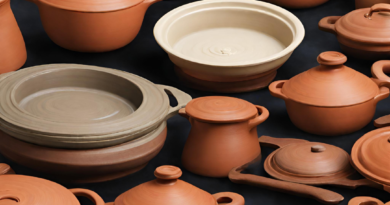What are the differences between clay pots and metal cookware?
When it comes to choosing cookware for your kitchen, you’ll find a wide range of options, including both clay pots and metal cookware. Each type of cookware offers distinct advantages and characteristics that can significantly impact your cooking experience and the flavors of your dishes. In this article, we’ll delve into the key differences between clay pots and metal cookware, helping you make informed choices for your culinary needs.
1. Heat Retention and Distribution:
Clay Pots: Clay pots excel at retaining and distributing heat evenly. The porous nature of clay allows for gentle, consistent heat transfer, reducing the risk of hot spots. This even heat distribution is ideal for slow-cooking dishes, resulting in tender and flavorful outcomes.
Metal Cookware: Metal cookware, such as stainless steel and cast iron, also retains heat well but can sometimes have hot spots. Cast iron, in particular, is known for its ability to hold and distribute heat evenly once it’s fully heated. However, it may take longer to reach the desired cooking temperature compared to clay.
2. Moisture Retention:
Clay Pots: Clay pots are excellent at retaining moisture within the cooking environment. As they absorb and slowly release moisture, they create a natural self-basting effect that keeps dishes moist and prevents excessive evaporation. This is particularly advantageous for braises, stews, and dishes that benefit from slow, moist cooking.
Metal Cookware: Metal cookware does not retain moisture as effectively as clay pots. While lids can help trap some moisture, metal cookware tends to rely more on added liquids or fats to maintain moisture levels in dishes.
3. Flavor Enhancement:
Clay Pots: One of the standout features of clay pots is their ability to enhance the flavor of food. The natural steam and moisture retention within the pot continually baste the ingredients, resulting in rich, complex flavors and enticing aromas. The porous surface of clay also contributes to flavor concentration.
Metal Cookware: Metal cookware can impart a different type of flavor, especially when it’s seasoned or well-used. Cast iron, for example, can add a subtle iron-rich flavor to dishes. However, this flavor is less pronounced compared to the flavor-enhancing qualities of clay.
4. Cooking Temperatures:
Clay Pots: Clay pots are best suited for low to medium heat settings, generally up to around 500°F (260°C). Using extremely high temperatures can risk thermal shock and cracking.
Metal Cookware: Metal cookware, such as stainless steel and cast iron, can withstand higher temperatures, making them versatile for a range of cooking techniques, including searing and high-heat roasting.
5. Versatility:
Clay Pots: Clay pots are particularly well-suited for slow-cooked dishes, braises, stews, and rice-based recipes. They are also favored for baking bread and certain desserts. Their versatility shines in recipes that benefit from gentle, moist cooking.
Metal Cookware: Metal cookware offers versatility for various cooking techniques, including frying, sautéing, searing, and high-heat roasting. They are often preferred for quick-cooking methods.
6. Care and Maintenance:
Clay Pots: Clay pots require specific care, including seasoning and careful handling to prevent cracking. They should be hand washed with warm water and a soft brush or sponge. Avoid harsh detergents and dishwasher use.
Metal Cookware: Metal cookware, such as stainless steel and cast iron, is generally more durable and forgiving. Cast iron, for example, requires seasoning to maintain its non-stick properties, but it can handle more rigorous cleaning methods, including scrubbing.
In conclusion, the choice between clay pots and metal cookware largely depends on your cooking style, preferences, and the specific dishes you enjoy preparing. Clay pots are prized for their ability to create moist, flavorful dishes, while metal cookware offers versatility and durability for a wide range of cooking techniques. Many kitchens find value in having both types of cookware to cater to various culinary needs.



